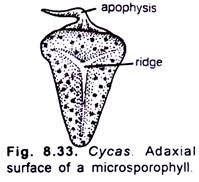ADVERTISEMENTS:
List of top two experiments on Imbibition in Plants: 1. Effect of Seed Coat on Water Absorption by Dry Seeds 2. Effect of the Nature of Seed on Water Absorption.
Experiment # 1. Effect of Seed Coat on Water Absorption by Dry Seeds:
The process ‘imbibition’ is considered as a special type of diffusion since the net movement of water is along a diffusion gradient. Dry seeds, when placed in water, show a noticeable swelling resulting in an increase in volume and weight of the seeds. The imbibition properties of seeds or dry plant materials are principally due to the presence of colloidal materials.
The rate and extent of the process is affected primarily by temperature, the nature of colloidal substances present that regulates the osmotic balance, nature of imbibants and also the seed coat impermeability. The seed coat acts as a permeability barrier as tested in terms of water absorption efficiency in seed with or without seed coat.
ADVERTISEMENTS:
Materials and Equipments:
1. Dry Gram or Pea seeds.
2. Beaker, Glass rod, Balance with weight box, Blotting paper, Forceps, Graph paper, Pencils etc.
Procedure:
ADVERTISEMENTS:
1. Place 5 gram seeds with seed coat in a 50 ml beaker. In another 50 ml beaker place 5 gms of gram seeds without seed coat (Fig. 3.5).
2. Put 30 ml dist. water in both the beakers and then keep both of them at room temperature i.e. 29 ± 1°C.
3. After 1 hr remove seeds from both the experimental sets and blot off their surface water by blotting paper.
4. Then weigh the seeds separately.
5. Finally, tabulate the initial and final weight and % of water absorption in the two sets and plot the data graphically to denote the effect of seed coat on water absorption efficiency by dry seeds due to imbibitional properties.
6. Repeat each experimental set mentioned above.
Inference:
ADVERTISEMENTS:
Seed coat acts as a permeability barrier.
Experiment # 2. Effect of the Nature of Seed on Water Absorption:
Inhibition in plant cells refers to the absorption of water by protoplasmic and cell wall constituents especially those of macromolecular dimensions (e.g. proteins, polysaccharides, etc.). The process involves both diffusion and capillary action. Thus rate and amount of absorption by different types of seeds vary because of their different protoplasmic constituents which control their imbibing capacity.
Materials and Equipments:
ADVERTISEMENTS:
1. Three different types of dry seeds viz. Gram (proteinaceous seeds), Paddy (starchy seeds) and Groundnut (fatty seeds).
2. Beaker, Glass rods, Glass marker, Balance with weight box, Blotting paper, Graph paper etc.
Procedure:
ADVERTISEMENTS:
1. Place 5 gms of three different types of seeds (with seed coat) in separate beakers (50 ml capacity).
2. Put 30 ml distilled water in each of the beakers and keep at room temperature (29 ± 1°C).
3. After 1 hr remove the seeds from the beakers separately and then blot off the surface water.
4. Weigh the soaked seeds separately.
ADVERTISEMENTS:
5. Record all the data in tabular form, and determine the % of water absorption by three different types of seeds.
6. Plot the data graphically for comparison (Fig. 3.7).
Inference:
ADVERTISEMENTS:
Results of the experiment show that the percentage of absorption of water is maximum in case of proteinaceous seeds and minimum in case of fatty seeds.





